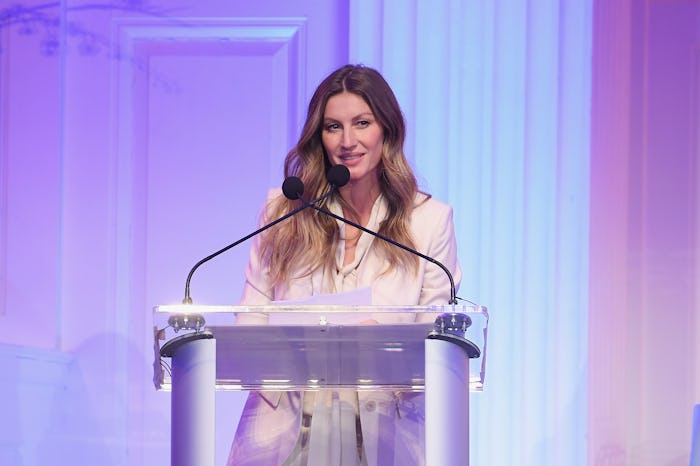Entertainment

Gisele Bündchen's Uneven Boobs Experience Is So Common
It's no secret that a woman's body undergoes massive physical changes during and after pregnancy. There are the stretch marks, the varicose veins, oh, and suddenly needing to cross your legs tightly before a sneeze — ah, the beauty of creating life! Another common question women have after giving birth: can breastfeeding cause breasts to become uneven? Many new moms would say absolutely yes.
Gisele Bündchen is one of these moms. In her new memoir Lessons: My Path to a Meaningful Life (available for purchase October 2, $28, Amazon), Bündchen details her journey from a young child in Brazil to the successful supermodel, committed wife, and doting mother of two that we know today. According to a sneak peek provided by People, she also opens up about a major point of insecurity she faced after the birth and breastfeeding of her children — uneven breasts — and a "secret" breast augmentation she underwent in 2015.
Bündchen spoke candidly to People about her struggles with her chest post-breastfeeding. “I felt very vulnerable, because I can work out, I can eat healthy, but I can’t change the fact that both of my kids enjoyed the left boob more than the right," Bundchen told People. "All I wanted was for them to be even and for people to stop commenting on it.” While, fortunately, everyday mothers won't have strangers on the internet sharing their opinions on their breast size (or sizes), insecurity clearly does not discriminate.
Molly Peterson, a Certified Lactation Counselor at Lansinoh, spoke to Romper about the very real changes that occur even before you begin breastfeeding. "During pregnancy, your body is preparing to breastfeed your little one, and you may notice that your breasts get larger, your nipples and areola get larger and darker, and veins in your breasts become more noticeable," Peterson says. "Even if you don’t breastfeed, these changes are already occurring during pregnancy."
Your breasts getting bigger is one thing, but will breastfeeding make them permanently lopsided? Yes and no, says Peterson.
"Most women’s breasts are actually uneven even before pregnancy or breastfeeding. It may become more noticeable during pregnancy and breastfeeding because your breast get larger and you can more easily see and feel the difference," Peterson explains. "Also many, if not most, women produce more breastmilk on one side, and this can further magnify the unevenness."
Turns out, there's an anatomical reason that this asymmetry can occur. Most women naturally have more milk ducts and alveoli in one breast than the other, according to an article by Today's Parent. Fun fact: that's typically a woman's left boob — the same boob that Bündchen mentioned her children favoring. Science!
Any woman who's experienced pregnancy and childbirth will tell you that it's impossible to control every physical change that comes along with these processes. Luckily, there are a few things you can do to help reduce asymmetry during and after breastfeeding. One way is to encourage your baby to nurse evenly on both sides, as recommended on the Medela website: "Use tactics to encourage baby to feed on the less preferred breast, such as trying new nursing positions, which could bring added comfort to feeding on that side. Or try offering the less preferred breast when your baby is drowsy and more willing to feed on that side." Additionally, a well-fitting nursing bra can reduce the risk that these changes in your bust will be permanent. Bündchen herself elected to go under the knife — though she admitted to People that this was a decision she regretted soon after.
Even if you luck out and finish breastfeeding with a perfectly symmetrical chest, it's inevitable that there will be other physical differences. Dr. Adam Kolker, a Manhattan-based plastic surgeon, spoke to Vogue about the sagginess many women report after breastfeeding. "When you’re pregnant, the glandular elements of the breast get considerably larger, so you see an increase in one or two cup sizes,” Dr. Kolker said. “Postpartum, the breast gland goes back down to the original size or ends up being a little less. Since the skin stretches during the period of growth, there’s an increase in discrepancy between the skin and the gland.”
Though it can be a frustrating cosmetic insecurity, there are no medical risks or concerns associated with these postpartum breast changes. No matter how beautiful pregnancy was or how "worth it!" breastfeeding is, these changes can be disheartening — and women shouldn't feel ashamed to admit that. However, it can be helpful to remember why your body looks and feels different than it did pre-baby. As Peterson reminds Romper, "You’ve created and nourished a new life, and that is pretty amazing."